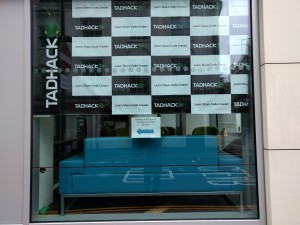 TADHack-mini London was larger that last year with 88 people through the door, 18 hacks, with more diversity of people involved, and many more hacks winning that required little coding. For example, using webhooks between Cisco Spark and IBM Bluemix. This is an important trend; the tools and platforms continue to democratize telecoms so more and more people can use it in their applications, services and business models. We had a total of $8k to distribute across the winners including a Trossen Phantom X Hexapod.
TADHack-mini London was larger that last year with 88 people through the door, 18 hacks, with more diversity of people involved, and many more hacks winning that required little coding. For example, using webhooks between Cisco Spark and IBM Bluemix. This is an important trend; the tools and platforms continue to democratize telecoms so more and more people can use it in their applications, services and business models. We had a total of $8k to distribute across the winners including a Trossen Phantom X Hexapod.
Every time we hold a TADHack, the quality and diversity of the hacks increases, regardless of location. The proof is clear, telecom app development is powerful and we’re only just scratching the surface of what is possible.
We also had some rookie JavaScript developers with us who had just completed a one week WebRTC course organized by Founders and Coders, and ipcortex. They took their ideas and projects from the course and mashed them up with the TADHack-mini London sponsors, who include:
- Apidaze: check out this interview with Luis the CEO on Apidaze on the impressive services being built on their API like ottspott and widget4call.
- Cisco Spark / Tropo: Check out this interview with Jason Goecke, GM of the Tropo BU in Cisco, who discusses their $150M Spark Innovation Fund. Hack at TADHack and potentially get some funding.
- Dialogic: Dialogic powers Telestax, they will be judging hacks built on Telestax.
- Matrix: is an amazing open source project that is becoming ever more popular, check out their blog, it is an open standard for decentralized communications.
- Telestax: check out how Sebastian Schumann took a hack built on Telestax at TADHack London last year commercial in less than 6 months.
This weblog reviews the rest of the hacks created at TADHack-mini London, as you can see the quality is extremely high. Igor Pavlov, founder and CTO of LyteSpark, and a regular at these events as this was his 3rd TADHack. Showed the LyteSpark Slack App . When you get into a chat session where jumping onto a video chat makes more sense, the LyteSpark app jumps in with a suggestion. LyteSpark has just launched a few weeks ago, yet that did not stop Igor hacking. Its a great example of how communications can be made effective. Messaging is fine, but sometimes talking so so much quicker, and that’s what the LyteSpark app does. You can download the Slack app here.
Another TADHack regular is the master hacker Sam Machin, who has recently joined Nexmo. Sam’s hack, DxRTC, was a great showcase of using the data channel of WebRTC, to enable 2 peers to find each other by swapping their GPS data. It enabled Sam to have a play with a number of data channel options, and create a sweet little application. Learning is an important part of every hackathon, and Sam shows its important to never top learning, even if you’re at the top of your game 🙂
Be My Friend was created by the team of Justin Grierson and Matt Williams. It used the Tropo as well as Telestax and Dialogic to capture voice and do sentiment analysis on the voice. The idea is to provide support to people with mental health issues. Matt did another amazing coding feat within the browser. Because today IVR’s generally do not support video he coded an application server in the browser – yes, you heard that right.
Faiz Rasool and Joel Barnett presented “Education Studio Live” using the resources from Telestax, Dialogic and Tropo. Its an Online Virtual Class room based learning platform. It uses face and eye detection to determine if someone is not focused on the class, and alerts the instructor to get the student better engaged.
Send what you see was created by Niall Roche and Daniel Fozzati. The hack used CiscoSpark to capture text using phone camera and sending the text (not the image) to a Spark room. It enabled Niall to explore a number of issues with the Spark Java API in Android.
Last, but definitely not least we wrapped up TADHack London with the Vaipo App by Siddartha Pothapragada who used Tropo. The application enables video chat connection between two registered users of the application seamlessly. User can use his phone number to register with the Vaipo cloud service. (or) Users can also use their gmail IDs / facebook IDs to register with our backend. Users can enable Video chat during a regular ongoing PSTN call.
